Not By Bread Alone
/Nineteen crewmen on the Titanic worked as bakers. A Liverpool native, Chief Baker Charles Joughin, 32, had worked aboard ships since his teen years. He was employed by the White Star Line to first work on the Olympic, Titanic’s sister ship, before being transferred to Titanic for her maiden voyage.
Charles Joughin - Photo credit Encyclopedia Titanica
While Titanic’s lifeboats were being loaded following the collision, Mr. Joughin was ordered to bring what he could in the way of provisions for the boats. He sent thirteen men to the boats, each with four loaves of bread. At some point while the ship was sinking, he began drinking alcohol in preparation for whatever lay ahead.
After surviving the disaster, he told the British Inquiry:
I went to my room and had a drop of liquor. When I went upstairs again, all the boats seemed to have gone, and I threw about 50 deckchairs overboard because I was looking for something to cling to….There was a buckling and cracking as if the vessel was breaking. I kept out of the crush of people… and she gave a great list to port and threw everybody in a bunch. The people were piled up, many hundreds of them. Just as I wondered what to do next, she went. I was not dragged under water, but I was in the water about two hours. I was just paddling until daylight came. Then I spotted what I thought was some wreckage.
The wreckage Mr. Joughin thought he found was actually Collapsible B, one of the extra lifeboats that had been launched just prior to the sinking. He tried to board, but the boat was upside down with about 25 men standing on top. He was pushed off, but hung on with the help of a cook. He eventually was picked up by another lifeboat. Some claim his ability to withstand the ocean's cold temperature was due to the amount of alcohol he’d likely consumed. Another source says he insisted he never even got his hair wet.
A boat from the Mackay-Bennett picks up Titanic's Collapsible B during recovery operations
photo credit Independence Seaport Museum
Mr. Joughin had also been on board the SS Oregon when it sank in Boston Harbor in 1886. After his rescue from the Titanic, he continued his employment with American Transport Lines and World War II troop transports. He died in 1956 and is buried near his home in Patterson, New Jersey.


